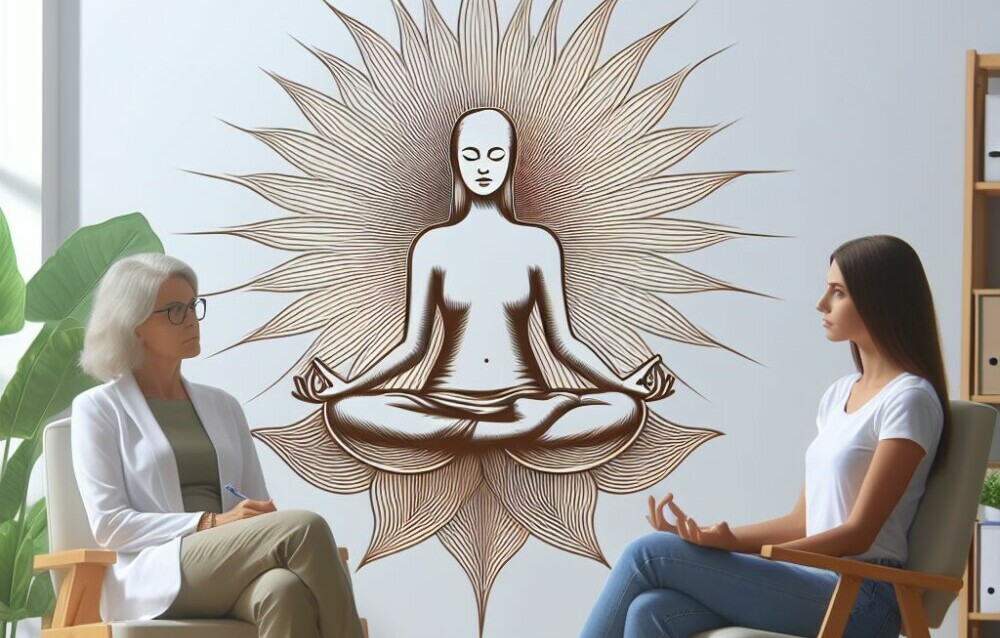
Guided Imagery has roots in both ancient wisdom traditions and modern psychology. It has been considered a bridge between the conscious and unconscious mind, allowing individuals to access deeper levels of insight and wellness. From the shamans of indigenous cultures to the psychotherapists of today, the use of mental imagery has been a constant tool for healing the body and the mind.
When it comes to healing the body and with Interactive Guided imagery we first need to know what makes it different from the traditional approach? Let’s explore that in the next section.
Interactive Guided Imagery Vs Guided Imagery
Here’s the deal with Interactive Guided Imagery (IGI), it’s not just your standard scripted guided meditation. You’re going to find out about how it’s both similar to and distinct from traditional Guided Imagery.
Guided Imagery is a technique that’s been used in various forms for centuries to promote healing and well-being. Guided Imagery is essentially a directed and intentional daydreaming process where you envision calming and peaceful images. This isn’t just about relaxation; it’s a therapeutic process that taps into your mind’s power to impact your body.
The effectiveness of Guided Imagery lies in its ability to harness the connection between the mental and physical realms. Studies suggest that the brain often doesn’t differentiate between real and vividly imagined experiences. Thus, by envisioning a certain state of health or calm, the body can be prompted to manifest those effects.
Guided Imagery involves a series of relaxation techniques and mental visualizations sometimes led by a therapist or self-directed using a recording. It’s like being read a vivid storybook of serene landscapes that engulfs your senses, leading to a state of calm. But what happens when these images evoke personal emotions, memories, or physical sensations?
That’s where Interactive Guided Imagery comes into play. It takes the passive experience of Guided Imagery and flips it on its head. Instead of just listening and visualizing, the client actively participates, often leading the narrative of the imagery themselves with a therapist acting as a skilled companion. In IGI there are no rigid scripts, instead it is an intensely personal experience.
The therapist’s role in IGI is to facilitate a dialogue with the client while they are in the calm relaxed state and actively using their imagination. They use carefully crafted questions and suggestions to help the client not only visualize but also engage with the imagery on a deeper level. It’s a dynamic back-and-forth that’s tailored to your personal healing journey.
During an Interactive Guided Imagery session, the therapist has the client describe in as much detail as possible the images, emotions, physical sensations, and thoughts that he is experiencing during the visualization process. With a skilled therapist pacing with the client through the experience it offers the added benefit to the client of feeling safe and understood, which doesn’t happen in traditional Guided Imagery.
IGI’s individualized approach allows for a direct addressing of personal issues, whether that’s combating anxiety, tackling a phobia, or managing chronic pain. Imagine having a psychological tool that’s designed precisely for your mental blueprint — that’s the beauty of Interactive Guided Imagery.
Benefits of Interactive Guided Imagery for Healing the Body and Mind
IGI fosters a profound connection between the mind and body. This synergy creates a fertile ground for healing and personal growth. Let’s dive into the tangible ways IGI can enhance your well-being.
IGI like traditional Guided Imagery offers the ability to reduce stress and anxiety. However it is much more than a stress reduction technique. IGI offers some of the following benefits as you delve deep into the subconscious?
- Personal Place Imagery – create a personal inner place in your imagination that is beautiful, safe, secure. A place you can go to anytime to relax and recharge, and to heal. This is the starting point in any IGI therapy work, it is vital to have a safe place to return to.
- Evocative Imagery – use IGI to evoke a much needed emotional quality or feeling state such as courage, patience, or determination that will support you in upcoming challenges.
- Inner Advisor Imagery – this is also one of the cornerstones of using IGI. Meet an inner helper who is a wise, kind, a supportive cheerleader, someone you can go to when you need advice, or guidance. This guide (or these guides, someone can have many inner advisors) will assist as you seek relief and personal growth in your sessions.
- Inner Child Imagery – meet your inner child. Heal emotional wounds from childhood. Visit with your inner child and let them know they are no longer alone.
- Somatic Imagery – it has been effective in pain management, get in touch with physical symptoms in your body and dialogue with the pain in order to get relief by altering your perception of pain. Use imagery to improve tolerance of medical procedures, such as surgery or cancer treatment.
These are just some of the ways that you can use Interactive Guided Imagery, it has been found to be useful in working with PTSD, addictions, phobias, it shows promise in improving mental health conditions, including depression, and in life transitions and personal transformation.
IGI isn’t a quick fix but a path to long-term resilience. By regularly engaging with the practice, you can build emotional strength that equips you to better handle life’s ups and downs. Your increased self-awareness can lead to improved relationships and a more balanced life.
The Process of Interactive Guided Imagery Therapy

Understanding what happens during an Interactive Guided Imagery (IGI) session prepares you for this unique therapeutic experience. It’s a collaboration between you and the therapist, or perhaps you and your Inner Advisor. Each session can be quite different, working through an issue over several sessions, or it can be directed towards what you’re going through at the moment. It is important to be open to whatever shows up without judgment.
After doing an assessment, you and your therapist will determine how to use the session. The therapist will help you ease into a state of calm usually guiding you into a relaxed state as you go to your personal place. Your personal place can be one that you know well and wish to visit in your imagination now or one that you create in the moment that just comes to you.
Next, the therapist guides you to help get you started, stirring the imagination. IGI can be very permissive where the client goes into the experience and asks the images questions, or meets with their inner guide, or at times it will be more directive where the therapist is asking more questions and doing more guiding. It will depend on the work being done, and with your therapeutic goals. Your active participation shapes the session as you describe your sensory responses.
Feedback is pivotal. As you explore imagery, your thoughts, feelings, and physical sensations are critical. This interactive component is what sets IGI apart; you’re not passively absorbing, but actively shaping the healing process.
Often, IGI is integrated with other forms of therapy, like cognitive behavioral therapy, tapping, or mindfulness, enhancing overall wellness. This isn’t a one-size-fits-all approach. The beauty of IGI lies in its flexibility and adaptability to your individual journey.
Getting Started with Interactive Guided Imagery
If this is sounding interesting and you are thinking about stepping into the world of Interactive Guided Imagery, you’re on the path to a potentially transformative experience.
A place to start might be getting more information. There are a several really good books that have come from Dr Marty Rossman “Guided Imagery For Self-Healing” and Dr David Bressler “Free Yourself From Pain“, the founders of the Academy of Guided Imagery. The Academy of Guided Imagery also has several recording for purchase so you can experience it on your own.
Finding the right therapist who specializes in this method is also helpful, especially if you are experiencing adverse symptoms from trauma or abuse. Online directories, testimonials, and recommendations from healthcare professionals can be great starting points.
Once you start, don’t just limit your practice to the therapy room. You can continue to benefit from Interactive Guided Imagery by practicing the techniques you’ve learned during your research or from sessions on your own. This will help reinforce the work you’re doing and make the healing effects even more pronounced.
And when it comes to setting goals and tracking your progress, choose something that resonates with you. Maybe it’s a sense of calm, a decrease in pain levels, or increased mental clarity. You can always adjust your goals as you evolve with the practice.
Final Thoughts
I really hope that you feel encouraged to explore Interactive Guided Imagery as a therapeutic option. With its personalized approach and deep roots in the mental and physical facets of wellness, it might just be what you need to find greater balance and well-being in your life.
In my opinion, if you unleash the power of your mind through IGI, you’re going to find not only an improvement in your current state but also a lifelong companion in your journey to holistic health.
If you are interested in learning more about how I use Interactive Guided Imagery in my practice please feel free to reach out to me at mj@tappingintohealing.net and I will be happy to schedule a 20 minute consultation.
